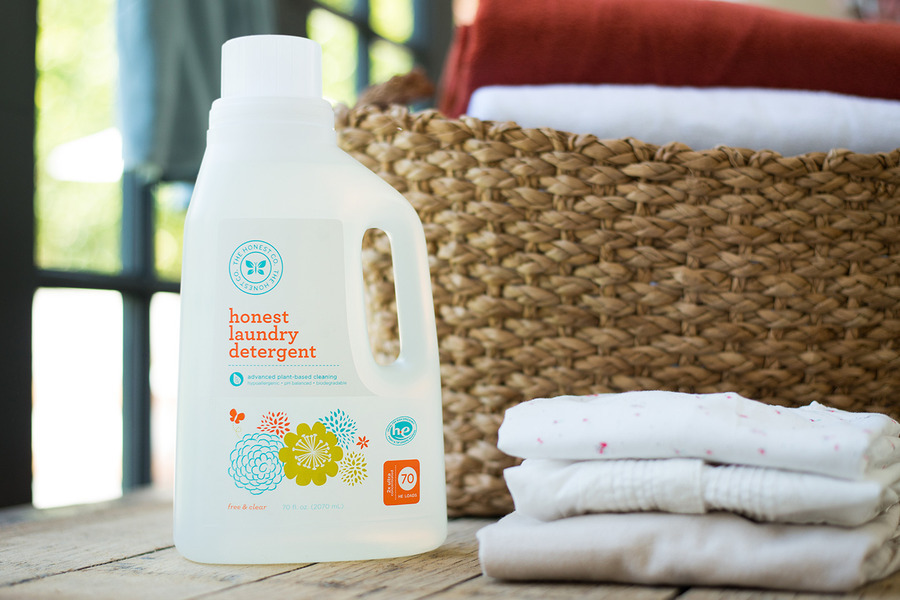Our Take on Honest Company’s Laundry Detergent & SLS
On March 10th, 2016, The Wall Street Journal published an article entitled, “Laundry Detergent From Jessica Alba’s Honest Co. Contains Ingredient It Pledged to Avoid.” The newspaper was referring to a chemical called SLS, Sodium Lauryl Sulfate. In numerous places, Honest Company lists SLS as an ingredient they avoid in formulating their products, yet The WSJ had two separate labs test Honest’s laundry detergent and claimed that both detected this chemical.
The reason this is an issue is that Sodium Lauryl Sulfate, used to create suds, has been known to cause skin irritation. Through our own research, Sprout has found that it is not a toxic chemical in the way that Sodium LAURETH Sulfate, a different SLS, is known to be. However, we choose to avoid carrying products for babies that can be irritating to their skin. What worried us most about the finding, was that Honest claimed this ingredient was not used. We worried that they might not know what’s really in their products.
Honest publically responded soon after, explaining that the Journal’s labs were incorrect and that they use a chemical called SCS, instead of SLS. Sprout pressed them on how the WSJ’s lab tests could have gotten this wrong. This was the response we received:
“In the article, the Journal alleged that testing showed our laundry detergent contains sodium lauryl sulfate, or SLS, a potential skin irritant. The conclusions of those tests are simply wrong—they’re based on a poor understanding of the science involved. Our products do not contain SLS; we use only sodium coco sulfate, or SCS. We choose to use SCS because we are committed to making products for our customers that are both gentle and effective.
“Before the article was published, we provided the Journal with clear evidence that our products do not contain SLS, but they chose to ignore our facts and publish their incorrect conclusions.
“The Wall Street Journal did not test for SCS; it tested only for SLS. We believe SLS was allegedly “detected” in test samples because the process of testing broke up the large SCS molecule into smaller compounds that don’t exist in our products in isolation under normal conditions.
“The Journal has created a lot of confusion around the chemistry of SLS and SCS, so I'll explain the science to you.
“SLS and SCS are very different substances; they are identified in the scientific community (including Chemical Abstract Society (CAS), FDA, and CFTA) as two distinct, separate classification numbers and two different ingredients, and they have very different safety profiles.
“Both SLS and SCS can be made from coconut oil, but the manufacturing processes are different. Coconut oil contains several carbon molecules of varying lengths. When SCS is processed from coconut oil, it keeps the same combination of carbon molecules as its coconut oil source (C8-C18). Over 25% of SCS is made up of the larger C16 and C18 carbon molecules of coconut oil; these large molecules do not easily penetrate the skin, which is why SCS is much gentler to the skin than SLS.
“In contrast, SLS is more chemically processed than SCS and uses just the smaller C12 molecule. The first step of processing SLS is different than SCS; the coconut oil is first distilled to isolate just C12 from the original mixture of carbon molecules, after which further processing takes place. This crucial first step of isolating C12 before processing is what makes SLS a very different chemical than SCS. The end product SLS contains just the isolated C12 carbon chain, which is small enough to penetrate skin and potentially cause irritation.”
After independent research and consultation with scientific experts, we learned that coconut oil is a mixture of fatty acids. Between 24% and 57%* of it is the lauric acid that becomes SLS. When coconut oil is exposed to the sulfonation process, it becomes about 50% sodium lauryl sulfate.
To make SCS, the manufacturer turns the components of coconut oil into sodium sulfate salts. This mixture may be less irritating than pure SLS, however it would contain some component that is identical to SLS. If part of the SCS is made up of SLS identical molecules, it makes sense that the chemists found them.
One consultant explained to us, “It is similar to honey vs. pure cane sugar. I would rather eat a cookie sweetened with honey, but you just can't pretend it is sugar free.”
The key issue for us is understanding the level of irritation that SCS causes. If SLS is problematic enough that Honest and other personal care companies choose to avoid it in baby products, then is SCS really that much better? The numerous chemists with whom we have spoken believe the levels of irritation would be similar. Honest believes that SCS is significantly less irritating than SLS, therefore choosing to include one and not the other in its products. We have been searching for a quantitative measure, such as a test called a het-cam test where irritation is measured on the membrane of a hen’s egg, but have not found one for SCS. Until we see evidence pointing to a significant difference in the two ingredients, we will avoid selling products for use on a baby’s skin that contain either Sodium Lauryl Sulfate OR Sodium Coco Sulfate.
….
* Muhammad Siddiq, Jasim Ahmed, and Maria Gloria Lobo, Tropical and Subtropical Fruit Processing and Packaging (Wiley-Blackwell, 2012), 171-174.


